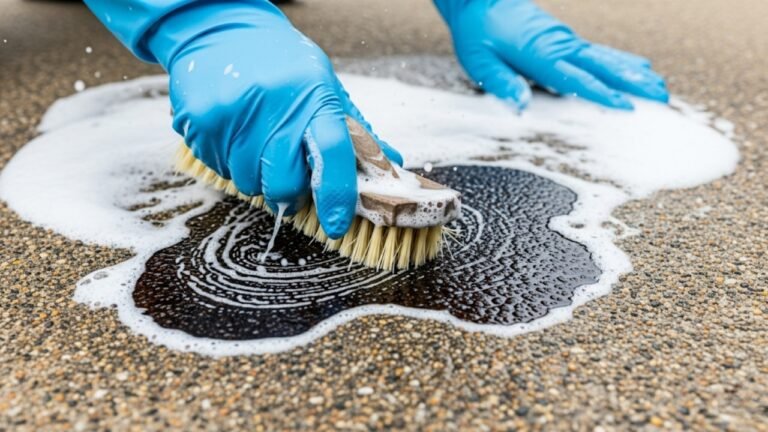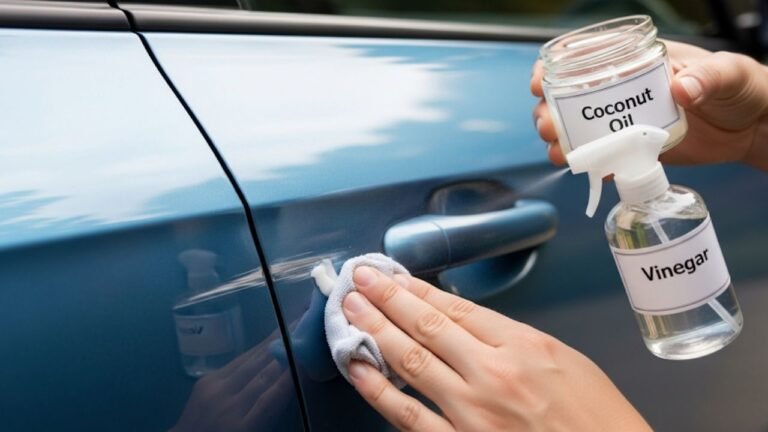How to Tell If a Car Is Leaking Oil: A Friendly Guide

Have you ever walked out to your car on a bright, peaceful morning only to see a little black puddle under your engine? That moment — when your stomach sinks and you mutter “Oh no…” — is something every car owner dreads. I’ve been there. One lazy Saturday morning, I spotted an ugly stain under my sedan, and just like that, my whole day took a detour.
Knowing how to tell if a car is leaking oil can save you from expensive repairs, sudden breakdowns, or worse — a blown engine in the middle of nowhere. Most people shrug off small leaks, but trust me, ignoring them is like ignoring chest pain — not a great idea.
In this article, we’ll break it all down simply. I’ll walk you through the signs, causes, checks, and stories to help you recognize an oil leak before it becomes a disaster. Let’s talk like friends, not mechanics.
In This Article
- 1 Why Cars Leak Oil: It’s More Common Than You Think
- 2 Obvious Signs Your Car Is Leaking Oil
- 3 Subtle Clues You Might Miss (But Shouldn’t)
- 4 How to Check for an Oil Leak at Home (Simple DIY Test)
- 5 What Happens If You Ignore an Oil Leak? (Spoiler: It’s Bad)
- 6 How to Fix an Oil Leak (Without Losing Your Mind)
- 7 When Should You See a Mechanic?
- 8 Common Myths About Oil Leaks (Busted)
- 9 FAQs About How to Tell if a Car Is Leaking Oil
- 10 Final Thoughts: Listen to the Leaks
Why Cars Leak Oil: It’s More Common Than You Think

Here’s the thing — your engine runs hot. It vibrates, expands, cools, and contracts. All those temperature changes wear out gaskets, seals, and rubber hoses over time. Even the smallest crack can lead to a slow, sneaky oil leak.
Here are the most common reasons your car might be leaking oil:
-
Worn-out gaskets or seals – These keep oil contained. When they fail, oil escapes.
-
Loose or broken oil pan – A bump or pothole can damage this.
-
Old or cracked valve cover gaskets – This is a classic leak point in older engines.
-
Oil filter issues – If it’s loose, over-tightened, or clogged, it could leak.
-
Drain plug problems – Sometimes it isn’t tightened properly after an oil change.
Now, these sound technical — but don’t worry. The point is, engine oil leaks are normal over time, especially if your car’s crossed 100,000 km or more.
Obvious Signs Your Car Is Leaking Oil
Let’s keep it real: the easiest way how to tell if a car is leaking oil is to look where your car sleeps.
If your car leaves behind puddles like a puppy that didn’t make it outside in time, that’s a huge clue. But oil leaks aren’t always dramatic. Some are stealthy.
Here are the big, loud signs you should NEVER ignore:
1. Oil Spots Under the Car
When you see dark brown or black stains under the engine, that’s usually motor oil. Unlike water (which evaporates), oil leaves greasy, slick marks.
-
Fresh oil looks golden brown.
-
Old oil looks thick, dark, and grimy.
Check every morning where your car was parked overnight.
2. Burning Oil Smell
Ever caught a sharp, acrid smell while driving or after stopping? That could be engine oil dripping onto a hot exhaust. It smells like burnt toast mixed with chemicals — not nice.
3. Smoke from Engine Bay
If oil touches hot metal, it can cause light smoke. You’ll notice it from under the hood. This isn’t just a leak — it’s a fire risk.
4. Low Oil Light or Dipstick Reading
When your oil light flickers or the dipstick reads low, and you didn’t skip an oil change, it’s a sign that oil is escaping.
Subtle Clues You Might Miss (But Shouldn’t)
Not every oil leak throws a parade. Some hide in plain sight. And if you’re not paying attention, you might only notice when it’s too late.
Here’s how to tell if your car is leaking oil silently:
1. Greasy Build-Up on Engine Parts
Open the hood (safely). If you see wet, dirty spots around the valve cover, gaskets, or oil filter, that’s a leak. Dust sticks to oil, forming grimy gunk.
2. Dripping or Misty Undercarriage
Look under the car — use a flashlight. Oil leaks often travel along metal parts before dripping. If the undercarriage feels greasy or looks wet, it’s time to investigate.
3. Oil on the Tires or Suspension
Oil shouldn’t touch your wheels. If it does, it’s coming from somewhere above — and that’s never good.
4. Oil Consumption Without Explanation
If you’re adding oil more often, even without visible leaks, it may be burning or leaking slowly. That’s your car whispering, “Help me.”
How to Check for an Oil Leak at Home (Simple DIY Test)
Sometimes you don’t need a mechanic. You just need a few minutes, some newspaper, and your senses. Here’s a DIY oil leak test I swear by:
What You Need:
-
Old newspapers or cardboard
-
Gloves and flashlight
-
Clean paper towel
-
A parking spot with level ground
Step-by-Step:
-
Park overnight on cardboard
Lay cardboard under the engine — front center. Leave it overnight. -
Inspect in the morning
Check for oil stains. Mark the location. -
Use the dipstick
Wipe it clean. Reinsert. Then check if the level is below the “MIN” mark. If it drops faster than usual, that’s your clue. -
Look under the car with a flashlight
Check the oil pan, drain plug, and filter. Wet areas or fresh drips mean a leak.
Quick Reference Table: Signs of an Oil Leak and What They Mean
| Sign | What It Means | Severity |
|---|---|---|
| Black/brown puddle under car | Active engine oil leak | High |
| Burnt oil smell | Oil on exhaust or hot engine | Medium to High |
| Smoke from engine | Leaking oil burning on hot parts | High |
| Low oil light | Ongoing leak or consumption | Critical |
| Sticky dirt on engine | Slow seep from gasket or valve | Medium |
| Clean dipstick but low | Oil leak or burn-off | Medium to High |
What Happens If You Ignore an Oil Leak? (Spoiler: It’s Bad)
Look, I get it. Life gets busy. Maybe you saw a tiny leak and thought, “Eh, not today.” But small leaks grow. And before you know it, your engine’s running dry.
That’s exactly what happened to a cousin of mine. He noticed spots, ignored them, and drove 400km to a wedding. His engine seized on the highway. The fix? A full engine replacement that cost more than his car.
Here’s what can happen if you ignore even a small oil leak:
-
Overheating: Oil cools your engine. Without it, metal parts grind and overheat.
-
Internal damage: Friction kills pistons, bearings, and the crankshaft.
-
Engine failure: Low oil = engine can’t lubricate = catastrophic damage.
-
Fire hazard: Oil touching exhaust can cause smoke or fire.
-
Environmental damage: Leaked oil seeps into soil and water systems.
It’s not worth the risk. If you suspect a leak, get it checked. Your future self will thank you.
How to Fix an Oil Leak (Without Losing Your Mind)
So, you’ve found the leak. Now what?
Fixing an oil leak doesn’t always mean opening your wallet all the way. Some issues are cheap and easy to solve. Others? They need a mechanic’s touch.
Let’s break it down:
Simple Fixes You Can Try at Home:
- Tighten the oil drain plug: It might be loose after an oil change.
- Replace the oil filter: If it’s old or clogged, that’s a common leak point.
- Add a sealant (carefully): Products like “engine stop-leak” can help temporarily. But don’t rely on it forever.
When You’ll Likely Need a Mechanic:
- Leaking valve cover gasket
- Cracked oil pan
- Front or rear main seal leak
- Head gasket failure
Tip: Always clean the area around the leak first. Then check again in a day or two to see if it reappears. If yes, it’s time to get help.
Fixing the leak early avoids bigger headaches. And honestly, seeing a clean driveway again is a great feeling.
—
When Should You See a Mechanic?
You know that feeling when something just doesn’t seem right? That’s your intuition talking.
If you’re unsure how to tell if a car is leaking oil and the signs are growing—smoke, smell, spots, low oil levels—it’s best to let a pro take a look.
Here’s when to go straight to a mechanic:
-
Oil puddles are getting larger every day
-
Dipstick reads low just days after adding oil
-
Your car smells like burnt toast after every drive
-
Engine starts running rough, hesitating, or overheating
-
There’s smoke (even light) from under the hood
Even if you’re a DIY kind of person, oil leaks can hide in tough-to-see places. Mechanics have lifts, dye testers, and experience. Think of it like going to the doctor—you wouldn’t ignore chest pain, right?
—
Common Myths About Oil Leaks (Busted)
Let’s clear up some confusion. There’s a lot of misinformation out there, and you deserve the truth.
❌ Myth 1: “A little oil leak isn’t a big deal.”
✅ Reality: A small leak today can become a big repair tomorrow. Oil starves your engine if it’s low.
❌ Myth 2: “It’s just condensation, not oil.”
✅ Reality: Condensation is clear and evaporates. Oil leaves a sticky, dark stain.
❌ Myth 3: “You can always smell or see an oil leak.”
✅ Reality: Some leaks are hidden. They don’t smell or drip—especially if they’re burning off.
❌ Myth 4: “Old cars just leak. It’s fine.”
✅ Reality: Age isn’t an excuse. Any car can leak, and you can fix it.
—
FAQs About How to Tell if a Car Is Leaking Oil
Here are some quick answers to questions that pop up all the time:
❓1. What color is leaking engine oil?
Fresh oil is golden brown or amber. Over time, it turns dark brown or black. It’s slick and has a strong smell. That’s your giveaway.
❓2. Can I still drive my car if it’s leaking oil?
Yes — but only short distances, and only if the oil level stays safe. If you see smoke or the oil light comes on, stop immediately.
❓3. How much does it cost to fix an oil leak?
Small repairs (like a gasket or drain plug) may cost $50–$200. Bigger ones (like oil pan replacement or main seal repair) can go up to $1000+ depending on your car.
❓4. Can an oil leak damage my engine?
Absolutely. Oil lubricates everything. Without it, metal parts grind together, causing overheating, wear, and eventually full engine failure.
❓5. Are oil leak repair additives safe?
Some are okay for temporary use. They can swell rubber seals to slow leaks. But they’re not permanent. Think of them like a band-aid, not a cure.
❓6. What should I do if oil is leaking on my driveway?
Clean it up quickly. Use cat litter, baking soda, or a degreaser to absorb the oil. Left too long, it can stain concrete permanently and even damage it.
❓7. How often should I check my oil level?
Every couple of weeks is smart. And definitely before long trips. If you’ve had a leak before, check more often.
❓8. Is it dangerous to have oil leak onto a hot engine?
Yes. It can cause smoke, a bad smell, or even start a fire in rare cases. Always treat it seriously.
—
Final Thoughts: Listen to the Leaks
Let me tell you something from the heart: your car talks to you. Not with words, but with signs — spots, smells, smoke, strange noises. Learning how to tell if a car is leaking oil isn’t just a mechanic’s skill. It’s a survival skill for every driver.
When I first started driving, I used to ignore everything. Oil light? Meh. Weird smell? Just the city. But every time I ignored my car’s cries, I paid for it later — with cash, time, and frustration.
But when I started listening? My car ran smoother. I drove safer. I saved money. And I felt in control.
So next time you see a little black dot on your driveway, don’t look away. That tiny stain could be your car’s way of saying, “Please help me.”
And now? You know exactly what to do.






